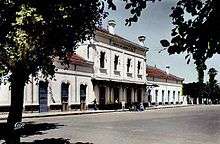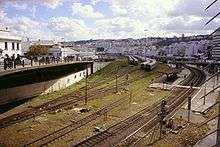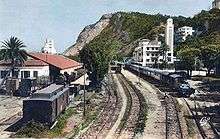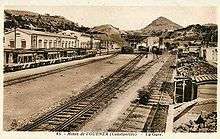National Company for Rail Transport
|
SNTF, votre partenaire idéal (French: SNTF, your ideal partner) | |
| State-owned | |
| Industry | Rail transport |
| Founded | March 31, 1976 |
| Headquarters |
|
Area served | Algeria, Tunisia |
| Products | Rail transport, Cargo, transport, Service, more... |
| Subsidiaries | See article |
| Website |
www |
The National Company for Rail Transport (French: Société Nationale des Transports Ferroviaires, abbreviated SNTF; Arabic: الشركة الوطنية للنّقل بالسّكك الحديدية) is Algeria's national railway operator. The SNTF, a state-owned company, currently has a monopoly over Algeria's network of 3,973 km (2,469 mi), even though it is currently exploiting only 3,572 km (2,220 mi). Out of the total railway network, 2,888 km (1,795 mi) are 1,435 mm (4 ft 8 1⁄2 in) standard gauge (283 km or 176 mi of these are electrified) and 1,085 km (674 mi) are 1,055 mm (3 ft 5 1⁄2 in) narrow gauge (as of 2008).[1][2]
History
The beginnings

The history of the railway in Algeria starts with the colonization of the country by France. On April 8, 1857, a decree orders the creation of 1,357 km (843 mi) of railway, beginning with a standard gauge line going from Algiers to Blida, started on December 12, 1859. The private Compagnie des chemins de fer algériens starts working on that line with the help of the French army on July 11, 1860. At the same time, the company got the permission to create an Oran-Sig line and a Constantine-Skikda line, however, due to economic difficulties, only the Algiers-Blida line was finished, and opened to the public on September 8, 1862. Afterwards, 5 other companies start the creation of new lines, these are:
- La Compagnie Bône - Guelma (BG)
- La Compagnie de l'Est Algérien (EA) (Eastern Algeria)
- La Compagnie Paris - Lyon - Méditerranée (PLM)
- La Compagnie de l'Ouest Algérien (OA) (Western Algeria)
- La Compagnie Franco - Algérienne (FA)
From 1857-1878, following lines (or parts of them) were finished, totalizing 1,365 km (848 mi), which is greater than the initial expectations:
- Annaba - Berrahal
- Annaba - Bouchegouf - Guelma
- El Khroub - Oued Zenati
- Constantine - Skikda
- Constantine - Sétif
- Algiers - Thénia
- Algiers - Oran
- Arzew - La Macta - Mohammedia
- Mohammadia - Mécheria
- Oued Tlélat-Sidi Bel Abbès
The nationalization

After 1879, France divided the railway lines being built of being of local interest or general interest, with only the latter being eligible to receive state funding. The July 18, 1879 decree defines the extent of some "general interest" lines and orders further 1,747 km (1,086 mi) of railways to enhance the existing network. From 1879-1906, following lines (or parts of them) were finished, totalizing 2,035 km (1,264 mi), which is; again; greater than the initial expectations:
- Souk Ahras-Tébessa-Le Kouif-Tunisian border
- Berrahal- Ramdane Djamel
- Ouled Rahmoune-Khenchela
- El Guerrah-Biskra
- Sétif-Thénia with further lines to include Tizi Ouzou, Béjaia and Sour El Ghozlane
- Blida-Berrouaghia
- Mostaganem- Relizane-Tiaret
- Oran-Arzew
- Es Sénia-Aïn Témouchent
- Sidi Bel Abbès-Tlemcen-Moroccan border
- Tabia-Crampel
- Méchéria-Béchar
- Tizi-Mascara
In 1946, Algeria's total railway network contained a total of 5,014 km (3,116 mi) of exploited lines, in addition to mine lines; that is overall much more than the current network. After a while, the private companies were unable to maintain economic stability, which led the French government to buy the Franco - Algérienne, Est Algérien, Bône-Guelma and Ouest Algérien in 1900, 1908, 1905 et 1920 respectively. On September 27, 1912, the state-owned Compagnie des Chemins de Fer Algériens de l'Etat (CFAE) takes over all lines, except those owned by the Compagnie Paris - Lyon - Méditerranée. On July 1, 1921, the CFAE and PLM agree to share the Algerian railway network with the PLM exploiting the Algiers-Oran, Oran-Aïn Témouchent, Sidi Bel Abbès-Tlemcen-Oujda-Crampel, Blida-Hassi Bahbah lines (in other words, Western Algeria) while the CFAE gets the rest. On May 30, 1938, both companies become incorporated into the newly founded SNCF, which handles all of France's railway network, with the Algerian network becoming a région. On January 1, 1939, the Office des Chemins de fer Algériens (Office CFA) is created, to specialize in the Algerian network. On June 30, 1959, an agreement is signed between the French government and the OCFA. On January 1, 1960 the Société des Chemins de Fer Français en Algérie is created as a result of the forementioned convention; until its replacement by the Société Nationale des Chemins de Fer Algériens (SNCFA) on June 16, 1963, a year after Algeria's independence
Post-Independence

The June 30, 1959 convention is maintained after the country's independence until March 30, 1976, when the SNCFA split into the companies:
- SNTF, for the exploitation and maintenance of the lines;
- SNERIF, for the renewal and extension of the network;
- SIF, for the engineering and modernization of the infrastructure.
This reorganization was to ameliorate the railway network and services and Algeria, however, as this didn't work out, the two latter companies were reintegrated into the SNTF. In 1980, a convention for the relations between the Algerian state and the SNTF was signed, officially called decree N° 88-128 of June 28, 1988, it is still used, and regulates; among other things; the salary of the workers and the maintenance of the infrastructure. It has several similarities with the June 1959 convention. Since December 1990, the SNTF became an EPIC.
Recent investments
Large investment programs were launched after 1980 to ameliorate the Algerian railway network, such as the creation of the Jijel-Ramdane-Djamel line (140 km or 87 mi), the Béni Saf area railway, especially for its cement plant (23 km or 14 mi), and in the Saïda (23 km) and Aïn Touta area (15 km or 9.3 mi).
In addition to that, about 1,400 km (870 mi) of track were renewed, both the track ballast and the railroad ties, as well as the doubling of the tracks of the Rocade Nord in Algiers (about 200 km or 120 mi). Many train stations all over the country were modernized, or even reconstructed, there were also many improvements to the railway, especially in the vincities of Algiers and Annaba.
A new, separate organisation, Anesrif, has been created to manage infrastructure investment whilst SNTF concentrates on day-to-day operations. Anesrif has awarded a series of contracts to build new infrastructure and upgrade existing lines, including the construction of a single-track line from Relizane to Tiaret and Tissemsilt; this forms part of the High Plateau line.[3]
Material
SNTF has:
- 222 Locomotives
- 9.855 Railroad cars
- 440 Passenger cars
Railway links to adjacent countries
1,435 mm (4 ft 8 1⁄2 in) gauge links were built to both Morocco and Tunisia. However, the land border with Morocco has since been closed.
Affiliations
SNTF is a member of the following organizations:
- International Union of Railways (UIC)
- Arab Union of Railways
- Comité du Transport Ferroviaire Maghrebin (CTFM) (The seats of this organization are in Algeria)
- African Union of Railways
See also
- Template:Suburban railways in Africa
References and notes
- ↑ "Transport in Algeria". CIA. Retrieved 2010-11-01.
- ↑ "SNTF website". SNTF. Retrieved 2008-02-23.
- ↑ "High Plateau railway construction contract". Railway Gazette. 2010. Retrieved 2010-05-10.
External links
- Official website (French)
- EngRailHistory The Railways of Morocco, Tunisia, and Algeria (Internet Archive)
| ||||||||||||||



